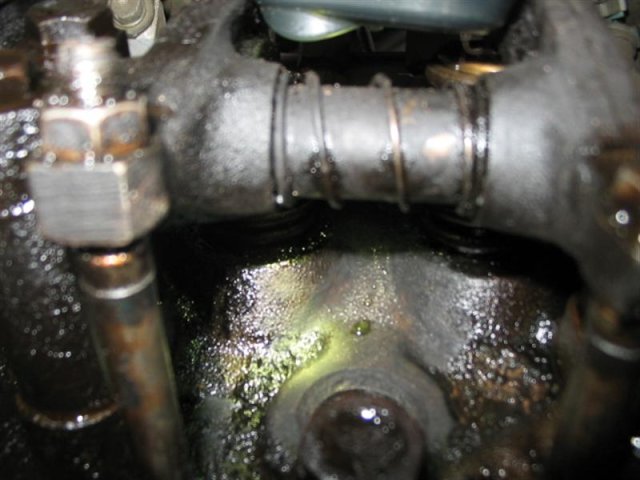Hey everbody thanks for all the replys. I thought that I would take a few minutes and post some pictures, and do a quick right up of what I have found so far. Hopefully someone can use this information and avoid all of the problems that I have had. Monday I bought my first fj62 from a fellow mudder. I found the add in the classifieds section. So I flew up to San Jose, performed a compression test and drove the vehicle. The oil was clean had good compression etc etc. The car stayed cool all of the way home but it used two gallons of coolant on a 8 hour drive. When I got home I did a bunch more testing and everything still came up negative. So I called a good friend that has had a few 62's and he said to check out the inside of the valve cover.
 Next he said to look directly under the rocker between cylinder 4 and 5. In that area I found 1/4" of a hard black substance (probably a quick radiator type fix stuff), I s****ed it off and then cleaned up the area really well, then I preasurized the cooling system to 14 PSI after a few minutes here is what I found.
Next he said to look directly under the rocker between cylinder 4 and 5. In that area I found 1/4" of a hard black substance (probably a quick radiator type fix stuff), I s****ed it off and then cleaned up the area really well, then I preasurized the cooling system to 14 PSI after a few minutes here is what I found.


If you look real close you can see the water drops comming out. The biggest drop is towards the bottom and then there are two more smaller drops in a straight line directly above it.In total it is about a 3/4" crack. So hear is what I have learned. My friend told me to pull the valve cover and check everything out. When I asked if we could the owner said no he didnt have a enough time for that and the motor only had 50K on it (and there were receipts proving that). I should have insisted that the valve cover come off. That would have told me everything that I needed to know. I would have probably still bought the 62 but a price that reflected e new head. It has definately been a learning experience. Unfortunately I cannot afford a new casting, So I found a used one from a toyota wrecking yard in Denver and the are going to ship it out with a warranty and then I am going to have it magnafluxed and rebuilt.



 Next he said to look directly under the rocker between cylinder 4 and 5. In that area I found 1/4" of a hard black substance (probably a quick radiator type fix stuff), I s****ed it off and then cleaned up the area really well, then I preasurized the cooling system to 14 PSI after a few minutes here is what I found.
Next he said to look directly under the rocker between cylinder 4 and 5. In that area I found 1/4" of a hard black substance (probably a quick radiator type fix stuff), I s****ed it off and then cleaned up the area really well, then I preasurized the cooling system to 14 PSI after a few minutes here is what I found.


If you look real close you can see the water drops comming out. The biggest drop is towards the bottom and then there are two more smaller drops in a straight line directly above it.In total it is about a 3/4" crack. So hear is what I have learned. My friend told me to pull the valve cover and check everything out. When I asked if we could the owner said no he didnt have a enough time for that and the motor only had 50K on it (and there were receipts proving that). I should have insisted that the valve cover come off. That would have told me everything that I needed to know. I would have probably still bought the 62 but a price that reflected e new head. It has definately been a learning experience. Unfortunately I cannot afford a new casting, So I found a used one from a toyota wrecking yard in Denver and the are going to ship it out with a warranty and then I am going to have it magnafluxed and rebuilt.
